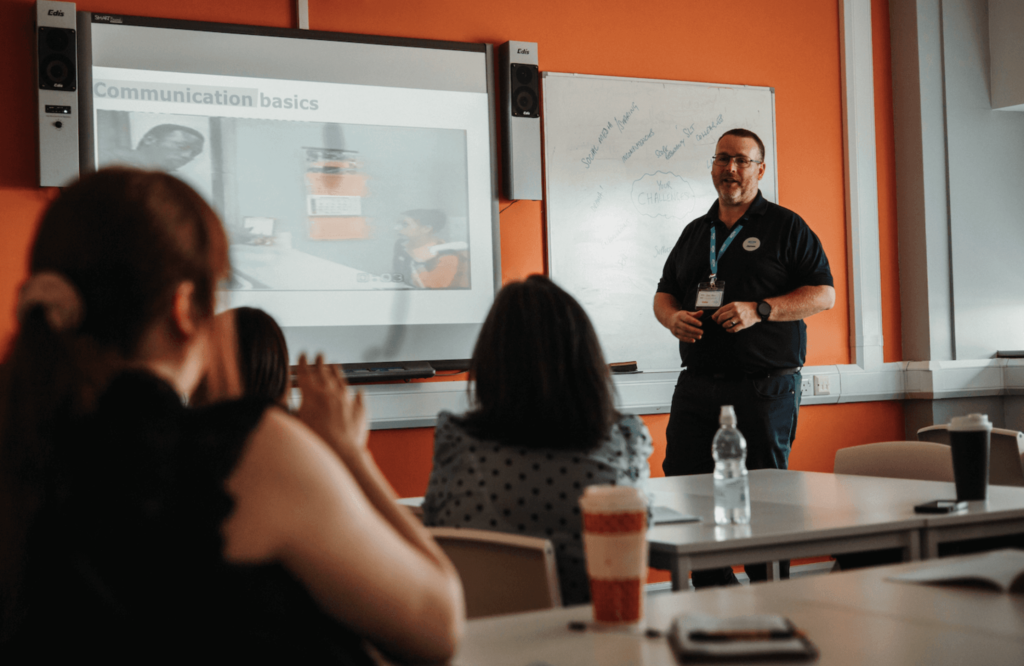What is the LEAPS communication model?

Written by James Adams – IKON Trainer
In the labyrinthine world of communication, misunderstandings often lurk around every corner. Conversations can quickly devolve into frustrating dead ends, leaving us yearning for deeper connection. Fortunately, there exists a roadmap towards effective communication, a framework rooted in evidence and empowered by empathy: the LEAPS method.
Within this acronym lies a series of valuable steps, each guiding us towards mutual understanding and collaboration. This blog delves into the intricacies of LEAPS, unveiling its transformative power for professionals seeking to navigate the complex landscape of managing challenging behaviour and conflict resolution.
What you will learn –
We hope the other party will be willing to hear our side of events and understand why we feel upset. If we reverse that thought, what can we do to help others feel understood?
There are many emotions attached to conflict, and these feelings can make it a challenge for those involved to reach a resolution. If we are able to access our rational self, we can follow some very simple yet effective steps, to understand and ultimately de-escalate many difficult conversations.
- Decoding LEAPS: Discover the power behind the LEAPS model—Listen, Empathise, Ask, Paraphrase, and Summarise—an influential guide through tough conversations and everyday interactions.
- Emotions in Resolution: Learn how LEAPS tackles the emotional layers of conflict, creating a space for understanding and de-escalation.
- Beyond Training: See how LEAPS extends beyond conflict resolution training, impacting day-to-day interactions for better understanding and resolution.
When faced with a situation in which you feel frustrated, anxious, or even agitated; what would you need from another person to feel acknowledged and heard?
The LEAPS model of communication is a simple and influential tool, to guide you through not only these challenging situations but also in your day-to-day interactions.
What does LEAPS stand for in conflict resolution?
LEAPS is an acronym that provides a communication model that helps when confronted with aggressive behaviour. The acronym stands for:
- Listen – A key component of the communication process is listening and is a fundamental skill in understanding a problem and being able to respond effectively.
- Empathise – Be interested in the other persons situation and try not to pre-judge or disapprove because you might approach differently.
- Ask – Using questions to get to the heart of the matter is important. This will demonstrate that you are concerned and interested in helping.
- Paraphrase – Put the facts as you see them in your own words and repeat your understanding to confirm you have understood.
- Summarise – Condensing the facts, being brief and decisive, may assist you taking the necessary action.
Our training courses, explore potential causes and underlying triggers to an individual’s behaviour (the Iceberg Theory); often, the trigger is the perception of not being listened to or acknowledged. It’s important to feel that our emotions are validated, and the LEAPS model of communication is designed to key into these basic needs.
Why use LEAPS to help in Conflict Resolution?
When we listen, actually listen, we can hear the real issues at hand, and the other person feels able to fully and safely say what they need to, without fear of judgement and without interruption. Active listening is a simple skill but is surprising how often we can get it wrong.
Our feelings, values, time pressures and workload, will all contribute to our tolerance, when faced with situations. We are only human! But how do we show we are listening? If we truly are, we don’t have to think about it, but indicators of ‘Active Listening’ may include positive eye-contact, paying full attention, not interrupting, vocal agreements (such as mmhmm, yes, ok), nodding and so on.
When we hear the other person completely, they feel listened to, validated and understood. That understanding creates empathy and genuine interest, which empowers us to move through the different stages to reach our options; offer alternatives, seek compromise and find a resolution.
If we demonstrate each step of LEAPS, it is unlikely that the other party will continue to display heightened behaviour, as such behaviour is designed to draw attention no longer needed in this instance. This directly relates to ‘behaviour breeds behaviour’ – Betari’s box and shows that when the time comes for us to respond, we are much more likely to be heard and acknowledged, moving the conversation forward constructively.

If we combine LEAPS with an awareness of how the environment, other people and distractions can impact our conversations, we can create a suitable time and safe space for this constructive interaction, increasing further the influence we will have on the outcome.
When reflecting on LEAPS as a tool for resolving conflict, I invite learners to offer examples of when they might have used LEAPS, and to revisit previous incidents where the use of LEAPS could have led to a preferable outcome. Usually, some interesting insights into people’s experiences alongside positive reinforcement reflect LEAPS as a simple but influential model.
Why do we use LEAPS during conflict resolution training?
As a trainer delivering conflict resolution training, I will introduce the communication model LEAPS to the learners.
LEAPS model is a structured approach to communicating in any situation (not just in confrontation). This approach may help you to establish some control within a potential conflict situation and when used in conjunction with Betaris Box forms the defusing and negotiation phases of the conflict continuum. When a complaint is expressed the key to resolving conflict is moving the problem to the problem-solving stage. Many people with a problem are not initially ready to problem solve because of an emotional reaction triggered by the upset.
Advice from our training experts
Incorporate the LEAPS model into effective de-escalation techniques as our experts advise. From creating a personal connection to exploring thoughts and feelings, these techniques are designed to navigate challenging situations with empathy and understanding.
10 Effective De-escalation Techniques:
- Engage: Create a personal connection using The LEAPS model of communication
- Reassure: Acknowledge concerns and anxieties. verbally and non-verbally.
- Clarify: Confirm understanding and ensure accuracy.
- Be transparent: Communicate openly about necessary actions.
- Distraction: Change the environment, task, or approach.
- Understand: Speak slowly and simplify information.
- Question: Replace multiple questions with statements or offer choices.
- Collaborate: Find compromises between needs and preferences
- Explain: Discuss options and choices, using facts and evidence
- Inquire: Explore thoughts and feelings using straightforward communication.
Conclusion
I enjoy teaching the LEAPS model, which is an invaluable tool during our training sessions; Delegates feedback that they have found this model a beneficial part of the course and will use it in their roles.
For more information regarding our training courses click on the links below or call us on 01473 927333
- Breakaway
- Conflict resolution
- Conflict resolution and personal safety training
- Lone worker
- Managing challenging behaviour
- NHS security teams managing violence and aggression
- Resolving telephone conflict

Written by James Adams – IKON Trainer
A fun and passionate trainer who delivers Conflict Resolution, Breakaway and Physical Intervention sessions to a variety of clients and sectors, coaching individuals and teams to gain awareness and techniques to manage and resolve unwanted conflict within challenging situations.
A conscientious and professional trainer and assessor with 20 years of experience in a frontline Ambulance Service, having developed and delivered bespoke and accredited training packages across a wide range of primary health care subjects.

